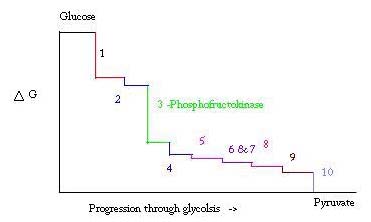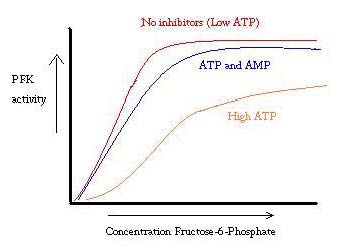Phosphofructokinase (PFK)
From Proteopedia
| |||||||||||
This Kinemage exercise consists of two kinemage scenes that illustrate some of the allosterically-induced conformational changes that occur in PFK from Bacillus stearothermophilus.
Contents |
Conformational Changes in a Dimeric Unit of PFK
This kinemage shows the two subunits of the tetramer whose interface contains two active sites. (KineMage currently not supported) The first view, 1: PFK dimer, shows the two subunits in their R state conformation as represented by their Ca backbones with Subunit 1 in pink tint and Subunit 2 in pink. Two side chains in each subunit are shown, those of Glu 161 (red) and Arg 162 (cyan), which are part of the F6P binding site in the T and R states, srespectively(see below). An F6P (hotpink) and an ADP (green; "ADP-active") are bound in the active site of each subunit. An additional ADP (yellow; "ADP-allo") is bound in a separate so-called allosteric site of each subunit. The ADPs each have an associated Mg2+, which is represented here by a ball of the same color as the ADP to which it binds.
Click the "ANIMATE" button to switch the dimer between its R and T states. In its T state, Subunit 1 is bluetint and Subunit 2 is skyblue. The side chains of Glu 161 and Arg 162 in both subunits are red and cyan as before (only the Ca and Cb atoms of the Arg 162 side chain in Subunit 1 are observed in the X-ray structure of the T state; those of Subunit 2 are all observed). The T state enzyme binds the inhibitor 2-phosphoglycolate (gold; "PGC"), a nonphysiological analog of the glycolytic intermediate phosphoenolpyruvate (PEP). Note that the binding site of PGC in the T state overlaps the allosteric binding site of ADP in the R state ("ADP-allo") and hence their binding is mutually exclusive. The T state active sites, which do not contain F6P, are marked by "ghost" F6Ps (gray;"F6P site"), which have the same positions as do the F6Ps in the R state enzyme.
The second view, 2: Allo/Act Sites, is a closeup of the upper portion of the first view showing both the active site and the allosteric site in this region. Note that the active site is located at the interface between two subunits and that the allosteric site interacts directly with the active site on the adjacent subunit. Compare the R state and T state conformations by displaying both at once or clicking on "ANIMATE". Can you identify the Mg2+ ion associated with each of the ADPs bound to the enzyme in the R state? Which ADP atoms coordinate these Mg2+ ions?
The phosphate group of PGC binds to the allosteric site in the T state in very nearly the same position that the beta phosphate group of "ADP-allo" binds to the R state allosteric site; both phosphate groups bind to the side chains of the same three residues (2 arg and 1 Lys; not shown).
In the high-activity R state, the positively charged side chain of Arg 162 forms a hydrogen bonded salt bridge with the negatively charged 6-phosphate group of F6P (white dashed lines), an interaction which presumably stabilizes the R state relative to the T state and is therefore in part responsible for F6P's homotropic effect.
The Major Conformational Changes in a Subunit of PFK.
This KINEMAGE shows those segments near the allosteric site (residues 53-60 are not shown here). As in KINEMAGE 1, the polypeptide is represented by its Ca chain with R state Subunits 1 and 2 in redtint and pink, and T state Subunits 1 and 2 in bluetint and skyblue. (KineMage currently not supported) KINEMAGE 2 comes up in view 1: The Allosteric Site, in the R state showing the phosphate group of F6P (hotpink) bound in the enzyme's active site in a hydrogen bonded salt bridge (dashed white lines) with the side chain of Arg 162 (cyan). An ADP (yellow; "ADP-allo") occupies the adjacent allosteric site. Click once on "ANIMATE" to switch to the T state. This replaces the ADP in the R state allosteric site with the inhibitor and PEP analog PGC (gold). F6P no longer occupies the active site but its position in the R state is indicated by the "ghost" F6P (gray; viewed by clicking on "F6P site").
What happens to the central polypeptide helical segment (residues 149-164) in the R to T transition? What does this do to the relative positions of the negatively charged Glu 161 and the positively charged Arg 162? Click on "F6P site". What influence would the absence of the positive charge of Arg 162 have on the binding of F6P? Does this explain, at least in part, why T state PFK has low affinity for F6P? Go to View 2: Closeup, for a closeup of the F6P-sidechain interactions. Center the molecules by choosing "pickcenter" from the "tools" menu and clicking on athe atom you'd like to be in the center. Slide the "zoom" slider to enlarge the view.
Site-Directed Mutagenesis
At one time, the negative charge of Glu 161 was thought to have a negative effect on F6P binding in the T state. This idea has not been supported by site-directed mutagenesis experiments[14].Several mutant PFKs have been made, including R162A, E161A and R162A/E161A. The R162A mutation caused a 30-fold decrease in F6P binding. The E161A mutation, however, had little effect on the ability of PEP to inhibit F6P binding.
3D structures of PFK
Updated February 2013
Phosphofructokinase
3o8l, 3o8n – PFK – rabbit
3o8o – PFK – yeast
2pfk – EcPFK-1 – Escherichia coli
3umo – EcPFK-2
2hig – TbPFK – Trypanosoma brucei
1zxx – PFK – Lactobacillus delbrueckii
6pfk, 3pfk, 3u39 – GsPFK – Geobacillus stearothermophilus
1u2x – PhPFK – Pyrococcus horikoshii
3hic – LiPFK – Listeria innocua
3opy – PFK – Pichia pastoris
4du5 – PFKB - Polaromonas
4a3s – PFK – Bacillus subtilis
PFK complexes
3n1c – EcPFK-2 + fructose-6-phosphate
3cqd, 3ump – EcPFK-2 + ATP
3uqe - EcPFK2 (mutant) + ATP
3uqd – EcPFK2 + fructose-1,6-bisphosphate + ATP
1pfk – EcPFK + fructose-1,6-bisphosphate + ADP
3drw – PhPFK (mutant) + ADP
3f5m – TbPFK + ATP
3ie7 – LiPFK + ATP
1mto - GsPFK (mutant) + fructose-6-phosphate
6pfk – GsPFK + phosphoglycolic acid
4pfk - GsPFK + fructose-6-phosphate + ADP
Pyrophosphate-dependent PFK
1kzh – PFK – Borrelia burgdorferi
3k2q – PFK – Marinobacter aquaeolei
3hno – PFK – Nitrosospira multiformis
Additional Resources
For additional information, see: Carbohydrate Metabolism
References
- ↑ Schirmer T, Evans PR. Structural basis of the allosteric behaviour of phosphofructokinase. Nature. 1990 Jan 11;343(6254):140-5. PMID:2136935 doi:http://dx.doi.org/10.1038/343140a0
- ↑ Voet, Donald, Judith G. Voet, and Charlotte W. Pratt. Fundamentals of Biochemistry: Life at the Molecular Level. Hoboken, NJ: Wiley, 2008. Print.
- ↑ Evans PR, Farrants GW, Hudson PJ. Phosphofructokinase: structure and control. Philos Trans R Soc Lond B Biol Sci. 1981 Jun 26;293(1063):53-62. PMID:6115424
- ↑ http://www.nature.com/nature/journal/v327/n6121/abs/327437a0.html
- ↑ Voet, Donald, Judith G. Voet, and Charlotte W. Pratt. Fundamentals of Biochemistry: Life at the Molecular Level. Hoboken, NJ: Wiley, 2008. Print.
- ↑ PubMed:2136935
- ↑ Campos G, Guixe V, Babul J. Kinetic mechanism of phosphofructokinase-2 from Escherichia coli. A mutant enzyme with a different mechanism. J Biol Chem. 1984 May 25;259(10):6147-52. PMID:6233271
- ↑ Voet, Donald, Judith G. Voet, and Charlotte W. Pratt. Fundamentals of Biochemistry: Life at the Molecular Level. Hoboken, NJ: Wiley, 2008. Print.
- ↑ Voet, Donald, Judith G. Voet, and Charlotte W. Pratt. Fundamentals of Biochemistry: Life at the Molecular Level. Hoboken, NJ: Wiley, 2008. Print.
- ↑ Voet, Donald, Judith G. Voet, and Charlotte W. Pratt. Fundamentals of Biochemistry: Life at the Molecular Level. Hoboken, NJ: Wiley, 2008. Print.
- ↑ PubMed:2136935
- ↑ Voet, Donald, Judith G. Voet, and Charlotte W. Pratt. Fundamentals of Biochemistry: Life at the Molecular Level. Hoboken, NJ: Wiley, 2008. Print.
- ↑ Campos G, Guixe V, Babul J. Kinetic mechanism of phosphofructokinase-2 from Escherichia coli. A mutant enzyme with a different mechanism. J Biol Chem. 1984 May 25;259(10):6147-52. PMID:6233271
- ↑ Kimmel JL, Reinhart GD. Reevaluation of the accepted allosteric mechanism of phosphofructokinase from Bacillus stearothermophilus. Proc Natl Acad Sci U S A. 2000 Apr 11;97(8):3844-9. PMID:10759544 doi:10.1073/pnas.050588097
External Links
Proteopedia Page Contributors and Editors (what is this?)
Michal Harel, Alexander Berchansky, Judy Voet, Ann Taylor, Jaime Prilusky, David Canner, Eran Hodis, Joel L. Sussman, Zach Westrick



